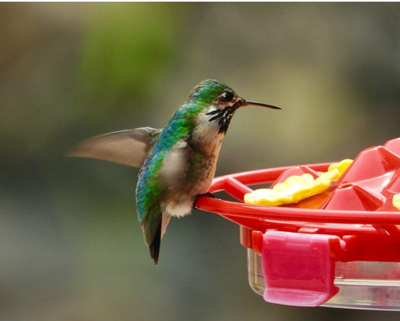Gardening: Syrup helps give hummingbirds energy they need for flight

The hummingbirds are back in our gardens after spending the winter in warmer places.
That means it’s time to make hummingbird syrup and hang up the feeders.
The male hummingbirds will show up first to stake out territory and scout out food sources. The females usually show up around a week later. Mine usually show up the third week of April looking for the feeder that hangs on the porch.
Once they discover each other, courtship begins with a series of wild flights as the males try to impress potential mates. They will swoop and dive around each other; the male often flies straight up and then straight down, almost hitting the ground. Once all the courting is done, they will build a tiny nest out of gathered fluff in a nearby brushy thicket.
The most common hummingbirds we see in Eastern Washington are the Rufous and Calliope, with occasional Black-Chinned and Anna’s hummingbirds. Once a pair of birds has established itself in your garden, its offspring will return every year.
For their size, about the weight of a nickel, hummingbirds are big eaters. It takes a lot of energy to beat their wings 200 times a second as they fly at an average speed of about 27 miles per hour – 40 if they want to hustle. They eat half their body weight in nectar and insects and eight times their weight in water every day.
Feeding hummingbirds is easy. Feeders are usually glass or plastic bottles fitted with red colored plastic feeding tubes or a sipping platform. Red is hummingbirds’ preferred color, and they will seek it out. Hang feeders where you can watch them but out of the direct sun or the easy reach of cats. Mine are hung under the eave of our front porch.
Making hummingbird nectar is simple. Mix four parts water to one part white table sugar and let the sugar dissolve completely. Store excess in the refrigerator for up to three weeks.
Don’t use brown or natural sugar, honey or artificial sweeteners as the birds need the pure sucrose found in white sugar. Do not add red food coloring and skip buying commercial nectar mixes with coloring in them. The dye can be harmful to the birds. Change nectar every week in cooler weather and every four to five days in the hot summer weather to keep it fresh.
To encourage them to stick around, make your yard a good place to hang out. Plant brushy, shrubby bushes, small trees and dense evergreens of any type around your property to provide nesting and roosting spots. The female hummingbird will build her golf-ball size nest out of moss, lichens and sculpted plant parts held together with spider webs in the lower branches of these bushes. Plant a variety of flowering plants that bloom at various times through the season to provide more sources of nectar.
Hummingbirds will eat many insects as a protein source, so skip using any insecticides.